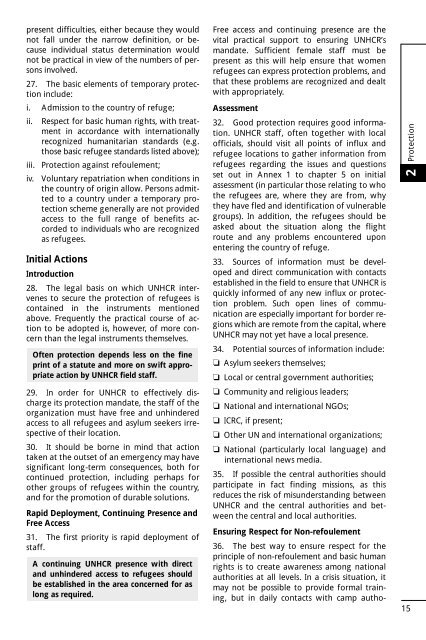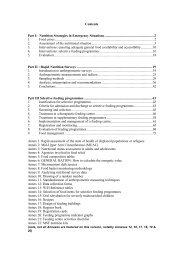UNHCR Handbook for Emergencies - UNHCR eCentre
UNHCR Handbook for Emergencies - UNHCR eCentre
UNHCR Handbook for Emergencies - UNHCR eCentre
You also want an ePaper? Increase the reach of your titles
YUMPU automatically turns print PDFs into web optimized ePapers that Google loves.
present difficulties, either because they would<br />
not fall under the narrow definition, or because<br />
individual status determination would<br />
not be practical in view of the numbers of persons<br />
involved.<br />
27. The basic elements of temporary protection<br />
include:<br />
i. Admission to the country of refuge;<br />
ii. Respect <strong>for</strong> basic human rights, with treatment<br />
in accordance with internationally<br />
recognized humanitarian standards (e.g.<br />
those basic refugee standards listed above);<br />
iii. Protection against refoulement;<br />
iv. Voluntary repatriation when conditions in<br />
the country of origin allow. Persons admitted<br />
to a country under a temporary protection<br />
scheme generally are not provided<br />
access to the full range of benefits accorded<br />
to individuals who are recognized<br />
as refugees.<br />
Initial Actions<br />
Introduction<br />
28. The legal basis on which <strong>UNHCR</strong> intervenes<br />
to secure the protection of refugees is<br />
contained in the instruments mentioned<br />
above. Frequently the practical course of action<br />
to be adopted is, however, of more concern<br />
than the legal instruments themselves.<br />
Often protection depends less on the fine<br />
print of a statute and more on swift appropriate<br />
action by <strong>UNHCR</strong> field staff.<br />
29. In order <strong>for</strong> <strong>UNHCR</strong> to effectively discharge<br />
its protection mandate, the staff of the<br />
organization must have free and unhindered<br />
access to all refugees and asylum seekers irrespective<br />
of their location.<br />
30. It should be borne in mind that action<br />
taken at the outset of an emergency may have<br />
significant long-term consequences, both <strong>for</strong><br />
continued protection, including perhaps <strong>for</strong><br />
other groups of refugees within the country,<br />
and <strong>for</strong> the promotion of durable solutions.<br />
Rapid Deployment, Continuing Presence and<br />
Free Access<br />
31. The first priority is rapid deployment of<br />
staff.<br />
A continuing <strong>UNHCR</strong> presence with direct<br />
and unhindered access to refugees should<br />
be established in the area concerned <strong>for</strong> as<br />
long as required.<br />
Free access and continuing presence are the<br />
vital practical support to ensuring <strong>UNHCR</strong>’s<br />
mandate. Sufficient female staff must be<br />
present as this will help ensure that women<br />
refugees can express protection problems, and<br />
that these problems are recognized and dealt<br />
with appropriately.<br />
Assessment<br />
32. Good protection requires good in<strong>for</strong>mation.<br />
<strong>UNHCR</strong> staff, often together with local<br />
officials, should visit all points of influx and<br />
refugee locations to gather in<strong>for</strong>mation from<br />
refugees regarding the issues and questions<br />
set out in Annex 1 to chapter 5 on initial<br />
assessment (in particular those relating to who<br />
the refugees are, where they are from, why<br />
they have fled and identification of vulnerable<br />
groups). In addition, the refugees should be<br />
asked about the situation along the flight<br />
route and any problems encountered upon<br />
entering the country of refuge.<br />
33. Sources of in<strong>for</strong>mation must be developed<br />
and direct communication with contacts<br />
established in the field to ensure that <strong>UNHCR</strong> is<br />
quickly in<strong>for</strong>med of any new influx or protection<br />
problem. Such open lines of communication<br />
are especially important <strong>for</strong> border regions<br />
which are remote from the capital, where<br />
<strong>UNHCR</strong> may not yet have a local presence.<br />
34. Potential sources of in<strong>for</strong>mation include:<br />
❏ Asylum seekers themselves;<br />
apple❏ Local or central government authorities;<br />
apple❏ Community and religious leaders;<br />
❏ National and international NGOs;<br />
❏ ICRC, if present;<br />
❏ Other UN and international organizations;<br />
❏ National (particularly local language) and<br />
international news media.<br />
35. If possible the central authorities should<br />
participate in fact finding missions, as this<br />
reduces the risk of misunderstanding between<br />
<strong>UNHCR</strong> and the central authorities and between<br />
the central and local authorities.<br />
Ensuring Respect <strong>for</strong> Non-refoulement<br />
36. The best way to ensure respect <strong>for</strong> the<br />
principle of non-refoulement and basic human<br />
rights is to create awareness among national<br />
authorities at all levels. In a crisis situation, it<br />
may not be possible to provide <strong>for</strong>mal training,<br />
but in daily contacts with camp autho-<br />
Protection<br />
2<br />
15



